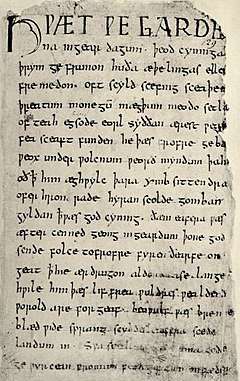Beowulf: A New Verse Translation
Beowulf: A New Verse Translation (also known as Heaneywulf) is a verse translation of the Old English epic poem Beowulf into the modern English language by Seamus Heaney. Translated throughout the late 1990s, it was published in 1999 by Farrar, Straus, and Giroux and won that year's Whitbread Book of the Year Award. It is dedicated in memory of poet and translator Ted Hughes.[1]
 First folio of the Anglo-Saxon copy of Beowulf. | |
| Author | Anonymous (Beowulf) |
|---|---|
| Translator | Seamus Heaney |
| Language | English, Old English |
| Subject | Old English poetry |
| Genre | Epic poetry |
| Published | 1999 |
| Publisher | Farrar, Straus, and Giroux W. W. Norton & Company |
| Pages | 256 |
| ISBN | 9780374111199 |
Plot
Heorot, the mead-hall of King Hroðgar of the Danes, is under nightly attack by the monster Grendel, killing the king's men as they sleep. The Prince of the Geats, Beowulf, comes to defend Heorot and defeat the monster Grendel, which he accomplishes by wounding the monster through unarmed combat. Soon after, Grendel's Mother comes to avenge her son, but Beowulf slays her as well, this time by using a sword found among the hordes of treasure in the Mother's cavernous abode.
Beowulf returns to the Geats and becomes their king, ruling for 50 years up until a great dragon begins to terrorize his people. The octogenarian Beowulf attempts the fight the new monster, which he accomplished but at the price of a fatal wound. As he lays dying, he declares Wiglaf as his heir. The old king is buried with a monument by the sea.
Background
Seamus Heaney hoped that translating Beowulf would result in "a kind of aural antidote," and a "linguistic anchor would stay lodged on the Anglo-Saxon sea-floor." Heaney began work on the translation while teaching at Harvard, but a lack of connection to the source material caused him to take a break from the effort. The translation was reinvigorated once he realized connections between the form and manner of the original poem and his own early poetic work, including how his early poems diverted from the conventional English pentameter line and "conformed to the requirements of Anglo-Saxon metrics."[2]
Reception
Professor James S. Shapiro stated that Heaney's Beowulf is "as attuned to the poem's celebration of the heroic as he is to its melancholy undertow"[3] and Joan Acocella has compared Heaney's version to the posthumous translation by J. R. R. Tolkien, but distinguishes that Heaney focuses more on the poetics rather than the details and rhythm of the original, creating a version more fit for the modern reader.[4]
References
- Heaney, Seamus (1999). Beowulf: A New Verse Translation. New York: Farrar, Straus and Giroux.
- Shapiro, James (February 27, 2000). "My Favorite Things, Part II". movies2.nytimes. The New York Times. Retrieved October 24, 2019.
- Shapiro, James (February 27, 2000). "My Favorite Things, Part II". movies2.nytimes. The New York Times. Retrieved October 24, 2019.
- Acocella, Joan (2 June 2014). "Slaying Monsters: Tolkien's 'Beowulf'". The New Yorker. Retrieved 8 June 2014.